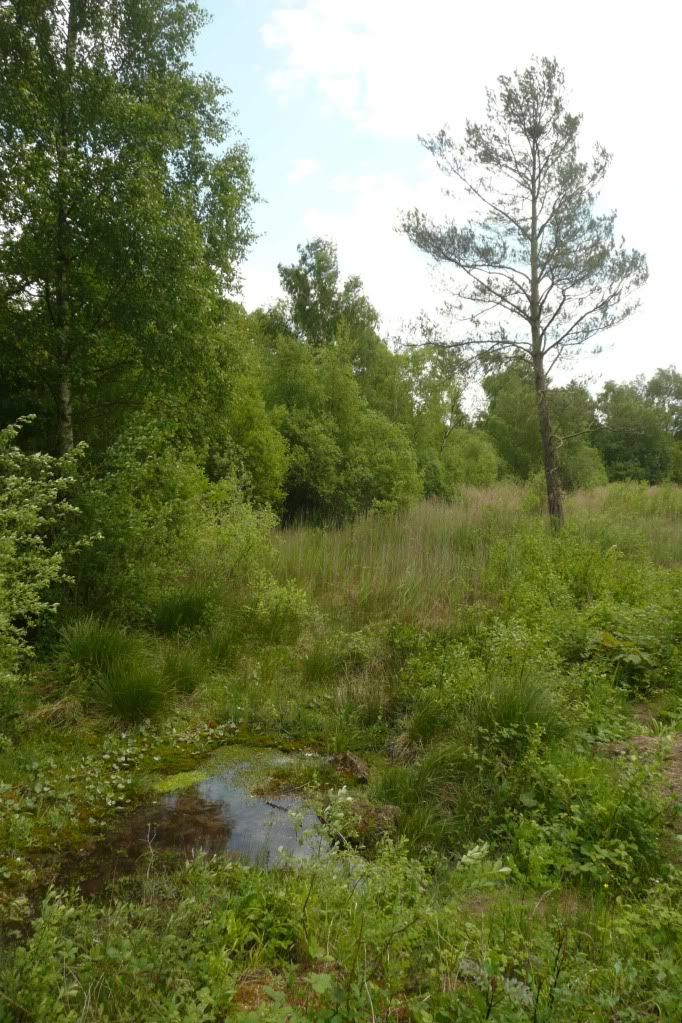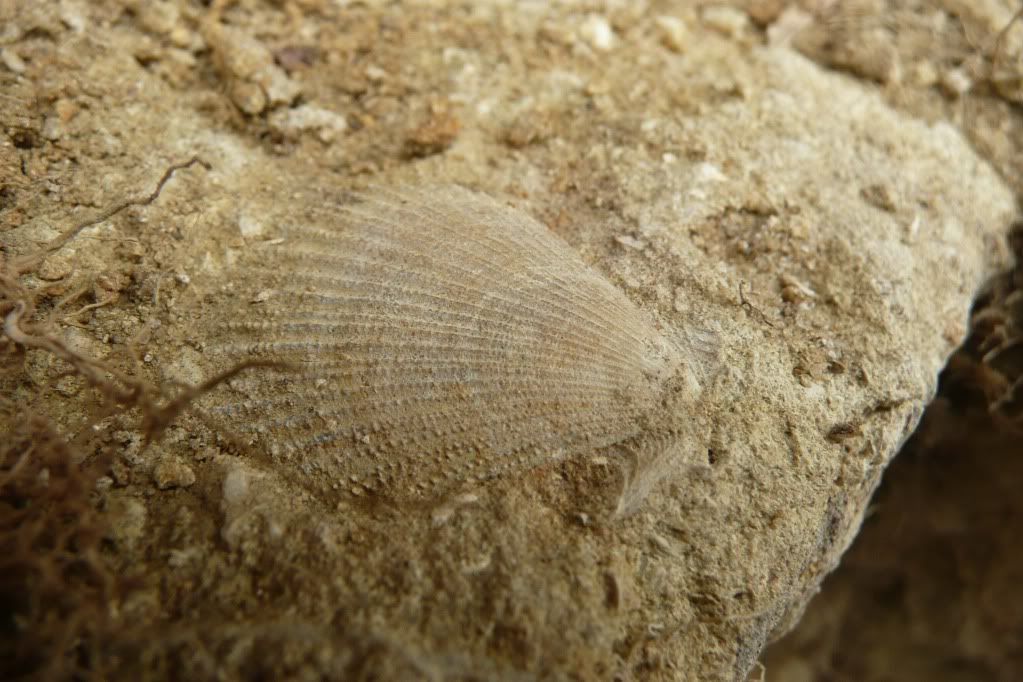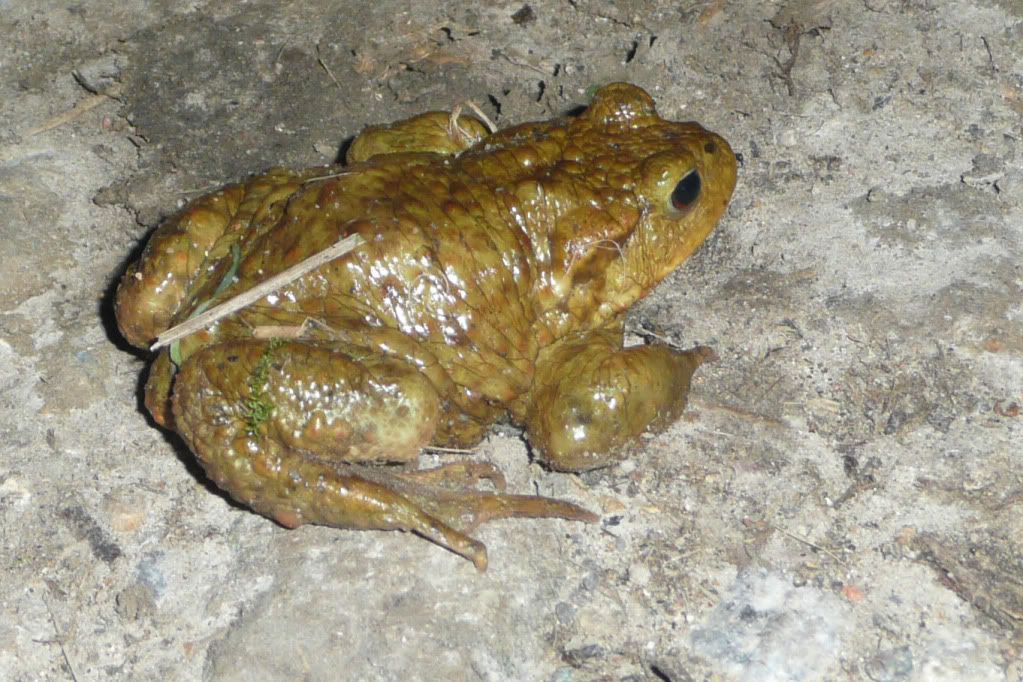Spring is the time of year when queen bumblebees emerge from hibernation, seek suitable nest sites and start a colony. Such as this buff tailed bumblebee I saw earlier in the year.
The colony then produces female worker bees, males and next years queens. Before it descends into chaos and eventually collapses towards the the end of the year.
There are may threats to bumblebees including parasitic wasps, mites and badgers. But one threat comes from another type of bumblebee - the cuckoo. There are six types of cuckoo bumblebee in the UK and this one, seen on the dandelions in the ock meadow, is a southern cuckoo bee:
As can be seen from it's markings, it looks very similar to the buff tailed bumblebee (on whose nests it mainly attacks), the main difference is the lack of a yellow band on it's abdomen and the thin yellow lines above the white tail:
Like its avian namesake, the cuckoo bumblebee takes advantage of the nests of others. It wakes later in the year and feeds off flowers whilst it finds a nest to parasitize. When it finds a nest the queen will hide herself inside, absorbing the smell. When this is complete, she will find and sting to death the existing queen, replacing her and subjugating the workers.
The new queen lays her own eggs, but these will only turn into males and queens who are attended to by worker bees from the deceased queen.
But life for a cuckoo bumblebee can be dangerous. If she selects a nest that is too established it's workers will attack and her. Apparently it's not uncommon to find several cuckoo bee corpses outside a nest.
As Martin says below 'nature can be harsh'.
Thanks to Natasha Rolph of the Bumblebee Conservation Trust for taking the time to answer my questions.
Wildlife and other things of interest on and around the river Ock in south Oxfordshire
Wednesday, 28 April 2010
Sunday, 25 April 2010
In search of ducklings
For most of it's length in Abingdon, it is unusual to find ducklings on the river ock. Probably the habitat that is excellent for water voles - steep banks and flowing water is not suitable for young ducklings.
But there are plenty of water ways where ducklings can be seen and probably the best is the Abbey Stream. This female mallard had unfathomable number of young - we lost count at 10:
But mallard ducklings feed themselves and were soon out looking for food on the banks.
Of course one of the reasons why ducks have so many young is that most of them will not survive. Sometimes this is due to predators, but sometimes it's other ducks. This female was very agitated as she was pursued by several males and trying to keep them away from her young.
There were also young coots (cootlings?) on the stream. Coots have a different approach to raising their young, they seem like caring parents, as the both of them feed their young:
Coot broods can be as high as ten and like ducklings, not all of them are going to make it adulthood. But coots have a rather unpleasant way of determining who will survive, they attack each of their young and it can be quite distressing to witness:
Eventually the weakest of the brood die from these attacks leaving only the strongest two or three.
Saturday, 24 April 2010
Photography
Rachel also said:
That's a very good picture. I'm very envious of you being able to get out and take such lovely shots. I just don't seem to have the time (or the skill with my camera)
That's a very good picture. I'm very envious of you being able to get out and take such lovely shots. I just don't seem to have the time (or the skill with my camera)
I use a Panasonic Lumix TZ3 compact camera. It has 10x optical zoom and 28mm wide angle and I consider myself to be an average photographer who gets lucky from time to time.
For example, on Thursday I saw a record 8 water voles, spent 1 hour minutes taking 36 pictures. Most of them were not particularly good:
Looks like I couldn't get the focus right on this one:
Damn, just missed it:
The combination of luck, patience and nearly 40 pictures the result in the occasional decent picture.
Thursday, 22 April 2010
Local Patch(es)
A splendid comment from Rachel in a previous post, has inspired me to write this, my 100th post.
I'm very envious of you being able to get out and take such lovely shots. I just don't seem to have the time (or the skill with my camera). I have some pretty good garden wildlife shots but that's as exciting as it gets. Any tips on how to get started further afield?
I think the best way to get started is to find, what some call, a local patch - an area you can easily visit and gradually learn the area. To give an idea of what can be found on the doorstep, I've dedicated this post to my local patches.
I am lucky (or greedy) to have three - close to where I live and work, where I can get out and escape and just enjoy the environment. The wildlife, the night sky or the interesting people you meet along the way. I venture to my local patches in the evening when I come back from work, grabbing a few minutes at lunch time or in even very early in the morning if I can't sleep - a good time for muntjac spotting.
The river Ock and meadow:
Right next to where I live and is the main focus of this blog - a place where water voles can be seen regularly, red kites fly overhead and kingfishers dart along the river. A haven, even if the A34 can intrude at times.
River Thames and Radley Brook
An area right next to where I work, there was once a strong water vole colony along the brook. But this seems to have suffered by the arrival of mink in the area. But on days like today, it's a stunning area just to admire the river
Or watch insects, like this speckled wood butterfly:
The Cothill Fens
Right next to Abingdon are five nature reserves that form the Cothill Fens. A diverse range of habitats that include man made fens:
And streams - including Sandford Brook - a tributary of the Ock:
As well as delightful fossils in the sandstone cliffs:
I don't think there is a better way to relax than to watch a water vole swimming across a river; seeing a queen bumblebee try and find a nesting site or watching a bird of prey circling up above or even the ostracods in the pond - who could have thought a 2mm crustacean could be so entertaining?.
The more I learn about these animals and places, the more I appreciate them - the internet, especially Wild about Britain and the blogs I follow have helped me identify and learn about many of things I've encountered.
So returning to Rachel's comments, my tips would be buy an ordnance survey map and explore where you live and work and use the internet to learn about what you see.
You never know, you might see a kingfisher, badger or like I did this evening, eight water voles.
Sunday, 18 April 2010
Hairy Footed Bee
Ironically, a hard weekend working the garden was rewarded by enjoying someone else's garden - the University of Oxford Botanic Gardens. As would be expected on hot spring days, the borders were alive with bees, including these small black ones - spring flower bees (also known as hairy footed bees).
Although it looks like a worker bumblebee, it is actually a solitary bee and can be seen seeking nesting sights in the sandstone walls of the gardens.
It also looks like a bee fly, but thanks to digital photography it can be shown it has two sets of wings and not one:
This post exists thanks to the excellent 'dog's life in the Tamar Valley' blog, which has a post on the same subject and was used for identification.
For better pictures of this oasis in Oxford, I refer you to Martin Gulliver's 'Gullivers Travel' Blog
Although it looks like a worker bumblebee, it is actually a solitary bee and can be seen seeking nesting sights in the sandstone walls of the gardens.
It also looks like a bee fly, but thanks to digital photography it can be shown it has two sets of wings and not one:
This post exists thanks to the excellent 'dog's life in the Tamar Valley' blog, which has a post on the same subject and was used for identification.
For better pictures of this oasis in Oxford, I refer you to Martin Gulliver's 'Gullivers Travel' Blog
Friday, 16 April 2010
Floating water vole
I saw this water vole, it seemed to be just floating on the river:
At first I thought it was dead or ill. But as I tried to get a second picture, I was pleased to be proved wrong:
At first I thought it was dead or ill. But as I tried to get a second picture, I was pleased to be proved wrong:
Thursday, 15 April 2010
More water voles
I haven't seen any water voles since my intial sightings in mid march. With the heavy rain a few weeks ago I was concerned that the resultant high water may have resulted in borrows flooding and the water voles drowning. Especially as I had more sightings this time last year.
However, a couple of walks along the river produced four new sightings
Again, not great quality pictures:
These sightings show the colony is once again establishing itself, as seen on the 2010 water vole map. These new sightings are in green - with March's sightings in blue
View Water voles 2010 in a larger mapSo there should be plenty of opportunities for better quality photos and perhaps now is the chance to explore further afield.
However, a couple of walks along the river produced four new sightings
Again, not great quality pictures:
These sightings show the colony is once again establishing itself, as seen on the 2010 water vole map. These new sightings are in green - with March's sightings in blue
View Water voles 2010 in a larger map
Tuesday, 13 April 2010
Another Brown Job
Last month I wondered if the new bird in the garden was a female reed bunting. It seems I (and my commenter) was correct, she has returned and this time bought a more identifiable male along:
Traditionally reed buntings nest near water, so the logical deduction would be they are feeding in the garden and nesting at the nearby river - either on the ground or in the reed beds. But these buntings have not only been enjoying the 'premium wild bird seed', but have been checking out the shrubs in the garden.
The RSPB state that the reed bunting population has collapsed by 50% since 1970 with an estimated 200,000 breeding pairs in the UK. So nesting buntings either in the garden or near the river would be a welcome sight.
Sunday, 11 April 2010
More Toads...
Thankfully, an early evening stroll has shown no sign of the feared toad carnage (no puns about Green Cross Toads here) and even in the last hours of daylight live ones are still about:
Toads spend most of their lives away from ponds and start the migration to their breeding ponds in autumn, taking a break in winter to hibernate, before continuing to their journey to their breeding pond in spring.
The females are considerably larger than the male, who attach themselves to the female - a technique known as amplexus. As there are often more males than females, breeding balls can be ensue, where multiple males try and breed with a single female (see picture in previous post) - occasionally resulting in her death as she is smothered or drowned. By being first and clinging on, this male will have an advantage over the other males.
The females are considerably larger than the male, who attach themselves to the female - a technique known as amplexus. As there are often more males than females, breeding balls can be ensue, where multiple males try and breed with a single female (see picture in previous post) - occasionally resulting in her death as she is smothered or drowned. By being first and clinging on, this male will have an advantage over the other males.
Thursday, 8 April 2010
Toads..
The astronomical bodies aren't the only things out at the moment. A late night walk down the lane has to be done carefully, as amorous toads are about:
Whilst others are still single:
And those that aren't single are not always successful:
Whilst others are still single:
And those that aren't single are not always successful:
I just hope when I return in daylight, the lane is not covered in squashed toad corpses....
Wednesday, 7 April 2010
Far above the Ock..
In the western sky two objects can be seen - the planets Venus and Mercury. Venus is the brightest one towards the top left. Whilst Mercury is the duller one on its right
Below them is the glow of light pollution from Swindon.
Below them is the glow of light pollution from Swindon.
Sunday, 4 April 2010
Blog birthday
The 5th of April 2009 was when this blog came to life, and to be honest I'm suprised it's lasted this long.
To celebrate, I bought a birthday cake (technically a Strawberry Charlotte) from the patisserie in town:
I also now feel part of the sizeable and diverse Abingdon blogs and have a small role in the multitude of wildlife blogs out there and I'd like to thank everyone who has read and commented on my blog.
To celebrate, I bought a birthday cake (technically a Strawberry Charlotte) from the patisserie in town:
When I started this blog 12 months ago, the focus was on the nearby water vole coloney. But it soon became an incentive to get out and explore the locality more, eventually finding evidence of badgers and otters less than a quarter of mile from where I live. I've also taken an interest in what I've found in my own garden, becoming fascinated by the ever expanding range of microscopic creatures that live in the garden.
Hopefully in the next 12 months I may explore further upstream - I would like to find the source of the ock in the wessex downs and maybe take look at some of it's tributaries including sandford and letcombe brooks as well as some of the other water ways in Abingdon - the river stert for example.
I also now feel part of the sizeable and diverse Abingdon blogs and have a small role in the multitude of wildlife blogs out there and I'd like to thank everyone who has read and commented on my blog.
Subscribe to:
Comments (Atom)































